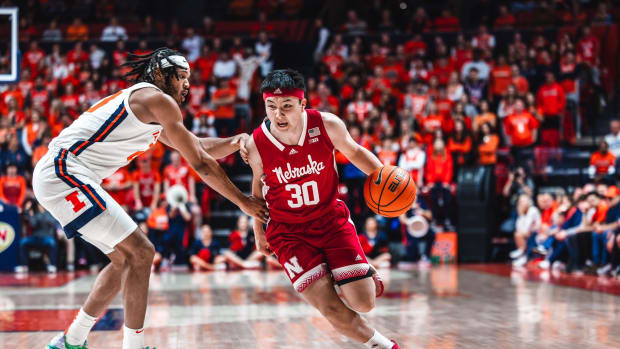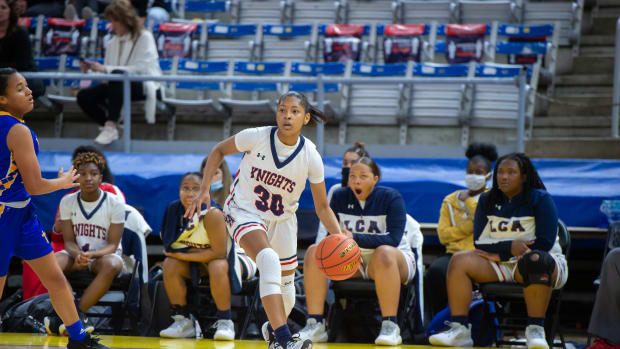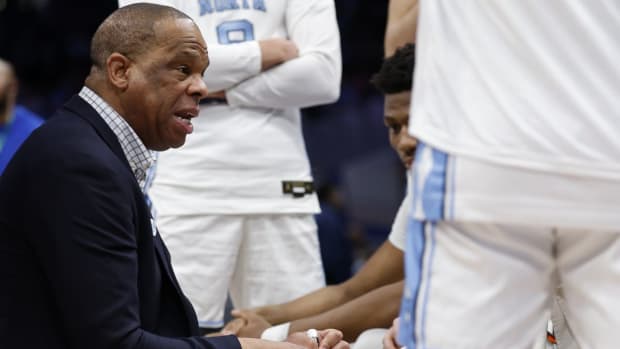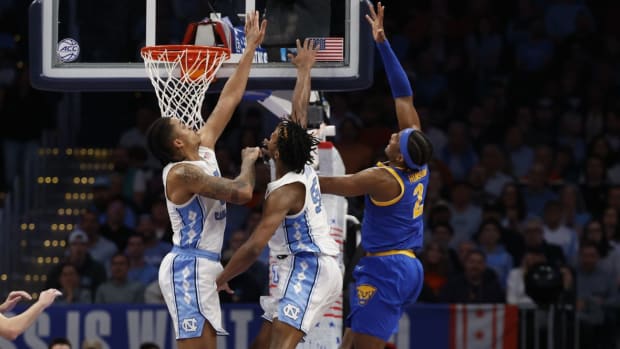Bracket Watch: The ACC's Best Are on Track to Crowd the Top Lines
The SI.com Bracket Watch Committee would like to use this still-early part of the season to get everyone on the same page regarding a handful of key bracketing principles. Last week, we touched on one of the well-known ones that states two teams from the same conference cannot play any earlier than the Sweet 16, and possibly not before the Elite Eight, depending on how many times the two teams in question saw one another in the regular season. To kick off this week of the Bracket Watch, we’re going to highlight another principle that will almost certainly come into play this season, thanks to the ACC.
Some years back, the writers of NCAA tournament rules decided that the top teams from the same conference should avoid one another until the Final Four, and for good reason. Spreading out elite teams from the same conference helps the committee build a bracket with the sort of competitive and geographic balance it wants. The exact rule states that if the top-four teams from one conference are all seeded fourth or better, they must be in different regions. In other words, if one conference produces four of the top-16 teams in the country, those four teams will be spread evenly across the four regions in the field. This, naturally, creates a domino effect, pulling in other bracketing principles, such as the one outlined in the first paragraph of this column. We’ll have a chance to track the impact of this principle all season because of the top of the ACC.
Power Rankings: Nation's Elite Teams Create Separation
Duke and Virginia are all but guaranteed to be seeded fourth or better, no matter what happens the rest of the season. Virginia Tech, North Carolina and Florida State are all comfortably in that mix, as well, and it wouldn’t take much for NC State to play its way into the top-quarter of the bracket. Even Louisville, while a longshot, could end up as No. 4 seed or higher if it uses last weekend’s win over North Carolina as a launching pad for a hot streak. With two teams locked in as high seeds, and at least three more obviously contending for one of the top-16 spots in the field, the ACC is a good bet to have its top four teams all seeded fourth or better. That means each region will have one of those four teams.
What if five teams earn top-16 seeds? Not only is it a useful question, it’s one the committee may need to answer. In fact, this Bracket Watch has Duke and Virginia as No. 1 seeds, Virginia Tech as a No. 3, and North Carolina and Florida State as No. 4s. That means two would have to be in the same region. In this scenario, the committee would still try to keep those two teams separate until the Elite Eight while also honoring the principle of keeping the top four teams in different regions. In this specific instance, that means our fifth ACC team, Florida State, would have to go with the conference’s lone No. 3 seed, Virginia Tech. That keeps the conference’s top-four teams away from one another, while also making sure its teams in the same region couldn’t meet until the Elite Eight.
Keep your eye on how these ACC teams move all season. It’s going to be one of the driving factors in how the actual bracket is built.
Which Conference Has Been the Deepest in 2018–19?
Last Four Byes
UCF
Texas
Temple
Arizona
Last Four In
Syracuse
Arizona State
Florida
Kansas State
First Eight Out
Butler
Alabama
Creighton
Clemson
Fresno State
Utah State
Saint Louis
San Francisco
Next Eight Out
Pittsburgh
Missouri
Arkansas
Notre Dame
Dayton
Davidson
Northwestern
Xavier
East Region
The top-four team principle doesn’t stop at the No. 4 line. NC State is the No. 6 seed in the East Region also because of that principle. The initial build of this bracket had the Wolfpack as No. 5 seed. However, there was no way to keep them there without violating the principle that teams from the same conference cannot meet before the Sweet 16. To do that, the Wolfpack would have had to go with Duke or Virginia, but there was no way to do that without forcing another No. 5 seed to play against someone from its conference. Thus, NC State had to get pushed down a seed line, with Auburn jumping up to a No. 5.
(1) Duke vs. (16) Sam Houston State/Prairie View A&M
(8) LSU vs. (9) Minnesota
(5) Buffalo vs. (12) VCU
(4) Marquette vs. (13) South Dakota State
(6) NC State vs. (11) Arizona
(3) Kentucky vs. (14) Loyola-Chicago
(7) Purdue vs. (10) Washington
(2) Texas Tech vs. (15) Montana
Midwest Region
Why is Gonzaga the No. 2 here, while Kansas is the No. 2 out west? It’s about rewarding the No. 1 seeds. If Michigan does indeed get the top seed in the Midwest Region, which is hosted in Kansas City this season, the committee wouldn’t exactly do it a favor by slotting Kansas as its No. 2 seed. That would be a virtual home game for the Jayhawks, and wouldn’t properly recognize Michigan as the region’s top seed. Michigan State also can’t be in this region because of the top-four team principle, which leaves Gonzaga and Texas Tech as our candidates. Either one could be here, but it’s Gonzaga that fits better, with fewer West Coast Conference teams than Big 12 teams to work around.
(1) Michigan vs. (16) Wagner/Norfolk State
(8) Iowa State vs. (9) Cincinnati
(5) Auburn vs. (12) Syracuse/Arizona State
(4) Florida State vs. (13) New Mexico State
(6) Villanova vs. (11) Murray State
(3) Virginia Tech vs. (14) UC-Irvine
(7) Nebraska vs. (10) Texas
(2) Gonzaga vs. (15) Marshall
South Region
There are still about two months until Selection Sunday, but it’s already safe to say that Mississippi is one of this season’s brightest surprises. Kermit Davis’s first season was supposed to be one of rebuilding, but the Rebels are 13–2 overall and 3–0 in the SEC with wins over Auburn and Mississippi State. Junior point guard Breein Tyree and senior wing Terence Davis give the Rebels one of the best 1–2 punches in the conference. The duo has thus far combined for 33.2 points, 9.1 rebounds, 6.8 assists and 2.2 steals per game, with both of them shooting better than 50% from the floor and 40% from behind the arc. This is a team to put on your watch list now.
(1) Virginia vs. (16) Lehigh
(8) Mississippi State vs. (9) TCU
(5) Indiana vs. (12) Florida/Kansas State
(4) Houston vs. (13) Vermont
(6) Iowa vs. (11) Temple
(3) Oklahoma vs. (14) Yale
(7) Ole Miss vs. (10) UCF
(2) Michigan State vs. (15) Radford
West Region
Michigan and Michigan State have separated themselves from the pack in the Big Ten, but the conference has a healthy middle of likely tournament teams that includes Maryland, Indiana, Wisconsin, Iowa, Purdue, Minnesota, Nebraska and Ohio State. Among those teams, Maryland looks the most dangerous three weeks into conference play. Junior Anthony Cowan gets into the lane and to the rack as well as any point guard in the country, and leads the team at 17.6 points per game. Bruno Fernando and Jalen Smith comprise one of the country’s best frontcourts, yet they’ve received little national attention. That’s likely to end after wins over Minnesota and Indiana pushed the Terrapins to 5–1 in conference, with their only loss coming at Purdue by two points. Their only other losses all season were to Virginia by five and Seton Hall by four. Maryland is a team on the rise.
(1) Tennessee vs. (16) Rider
(8) Seton Hall vs. (9) Ohio State
(5) Maryland vs. (12) Lipscomb
(4) North Carolina vs. (13) Hofstra
(6) Wisconsin vs. (11) Wofford
(3) Nevada vs. (14) Northern Kentucky
(7) Louisville vs. (10) St. John's
(2) Kansas vs. (15) Georgia State





